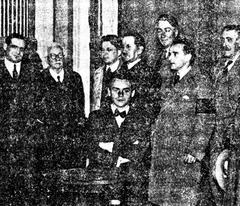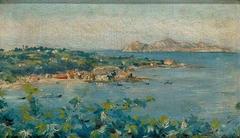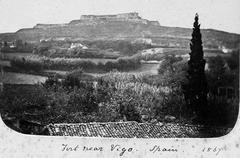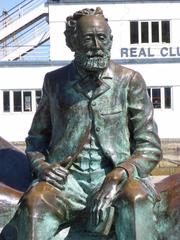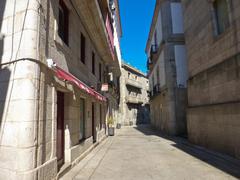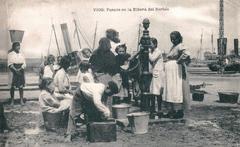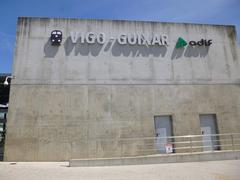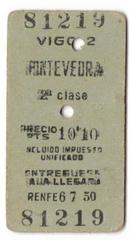
Pazo de San Roque, Vigo, Spain: Visiting Hours, Tickets, and Historical Sites Guide
Date: 04/07/2025
Introduction
Located at the gateway to Vigo, the Pazo de San Roque is a striking 17th-century Galician manor house that serves as both a testament to the city’s noble past and a vibrant hub for community life today. Originally built as a response to the city’s battles with plague epidemics, this estate has evolved into a cherished public park and cultural venue, seamlessly blending architectural grandeur, lush gardens, and a lively calendar of events. Whether you’re a history enthusiast, nature lover, or cultural explorer, this guide provides essential information on visiting hours, ticketing, accessibility, key features, and practical tips for an enriching visit to Pazo de San Roque.
For further planning, consult resources such as Paxinas Galegas, Faro de Vigo, Little Vigo, Atlántico, Minube, Turismo de Vigo, and Discovering Vigo.
Table of Contents
- History and Origins
- Architectural Highlights and Estate Features
- Gardens and Parkland
- Cultural Role and Community Events
- Visiting Hours, Tickets, and Accessibility
- Visitor Tips and FAQs
- Nearby Attractions
- Summary and Recommendations
- References
History and Origins
The Pazo de San Roque traces its roots to the late 17th century, with the adjacent Capilla de San Roque built around 1600 to honor Saint Roch, Vigo’s patron saint invoked during plague outbreaks (Paxinas Galegas). The manor house was established by the Méndez de Sotomayor family in 1688 and originally functioned as a rural residence and administrative center for local noble estates. Over the centuries, it mirrored Vigo’s fortunes, experiencing cycles of prosperity, decline, and restoration. In 1925, it was acquired by Caja de Ahorros Municipal de Vigo (now Abanca), which initiated major restoration and adaptation works, culminating in its current use as an event and community space (Paxinas Galegas).
Architectural Highlights and Estate Features
Manor House and Chapel
- Stone Masonry: Built from local granite, the manor house exemplifies Galician pazo architecture with robust walls, a castellated silhouette, and an imposing stone gateway adorned with heraldic shields.
- Capilla de San Roque: The historic chapel is a focal point for religious ceremonies and the annual festival, featuring a spacious nave, belfry (espadana), and 19th-century altarpieces (Little Vigo).
- Dovecote (Palomar): Traditional to Galician estates, the dovecote serves both decorative and historical roles.
- Music Pavilion: This modern addition hosts concerts and community events, reinforcing the estate’s cultural mission.
Layout and Functional Spaces
The main building covers approximately 640 m² over two levels, including event spaces, offices, restrooms, and hospitality facilities. The estate’s design integrates the manor, chapel, and ancillary structures into a cohesive landscape, accessible via winding paths and open lawns (Minube).
Gardens and Parkland
Spanning over 17,000 square meters, the estate’s gardens offer a diverse botanical collection featuring centuries-old oaks, chestnuts, camellias, birches, magnolias, laurels, and more. Once private, the grounds were opened to the public in 1935, now providing a tranquil retreat with shaded paths, open lawns, and scenic viewpoints (Discovering Vigo). The park serves as a vital green lung for the city and hosts family-friendly spaces, including children’s play areas.
Cultural Role and Community Events
The Pazo de San Roque is deeply woven into Vigo’s cultural and religious fabric. Its most significant event is the Romería de San Roque, held each August 16th, celebrating the city’s patron saint. The festival combines religious processions, traditional Galician cuisine, music, and communal gatherings, drawing thousands of participants annually (Faro de Vigo; Atlántico). The estate also hosts concerts, markets, and educational activities, fostering intergenerational connections and community engagement.
Visiting Hours, Tickets, and Accessibility
- Park and Gardens: Open daily from 8:00 AM to 8:00 PM (may vary seasonally).
- Manor House and Chapel: Access generally during special events and festivals, especially on August 16th.
- Admission: Free entry to park and gardens; special events inside the manor may require tickets (Turismo de Vigo).
- Guided Tours: Occasionally available during festivals; check local tourism websites for schedules.
- Accessibility: Paved paths are mostly suitable for wheelchairs and strollers, although some historic areas may be less accessible.
- Facilities: Restrooms, shaded benches, music pavilion, and limited on-site parking.
- Pets: Dogs allowed on leash; owners must clean up after their pets.
Visitor Tips and FAQs
Visitor Tips
- Festival Days: Arrive early during Romería de San Roque to find parking and a good spot, as crowds are large.
- Photography: The estate is especially picturesque during early mornings and late afternoons.
- Family Visits: The park’s open spaces and playgrounds make it ideal for families.
- Local Cuisine: Sample traditional Galician fare at nearby restaurants after your visit.
Frequently Asked Questions
Q: Is there an entrance fee?
A: No, admission to the park and gardens is free.
Q: Are the manor house and chapel open daily?
A: These are generally open during special events or festivals; otherwise, views are from the exterior.
Q: Are guided tours available?
A: Yes, occasionally during festivals and events. Check the Turismo de Vigo website for updates.
Q: Is the site wheelchair accessible?
A: Most of the park is accessible, but some historic areas may present challenges.
Q: Can I bring my dog?
A: Yes, dogs are welcome on a leash.
Nearby Attractions
- Castro Fortress: Panoramic views and ancient ruins (Castro Fortress).
- Old Town (Casco Vello): Historic streets and vibrant plazas.
- Castrelos Park: Vigo’s largest park, ideal for nature walks (Discovering Vigo).
- Fundación Sales: A botanical garden with diverse plant collections.
Summary and Recommendations
Pazo de San Roque is a model of adaptive heritage stewardship, offering a harmonious blend of historical architecture, botanical diversity, and dynamic community life. Its open parklands, vibrant festivals, and accessible facilities make it a standout destination in Vigo for visitors of all ages and interests. Special events such as the Romería de San Roque provide unique cultural immersion, while the tranquil gardens offer daily respite from the urban bustle.
Final Recommendation: For the most current information on events, visiting hours, and accessibility, consult official tourism sources and consider downloading the Audiala app for guided tours and interactive maps.
References
- Pazo de San Roque Visiting Hours, Tickets & Guide to Vigo’s Historic Manor House, 2024, Paxinas Galegas
- Pazo de San Roque Visiting Hours, Tickets, and Guide to Vigo’s Historic Manor and Gardens, 2024, Turismo de Vigo
- Cultural Significance of Pazo de San Roque, 2025, Little Vigo and Atlántico & Atlántico
- Pazo de San Roque Visiting Hours, Tickets & Guide: Explore Vigo’s Historical Gem, 2024, Minube and Discovering Vigo & Discovering Vigo
- Romería de San Roque Festival Coverage, 2023, Faro de Vigo


